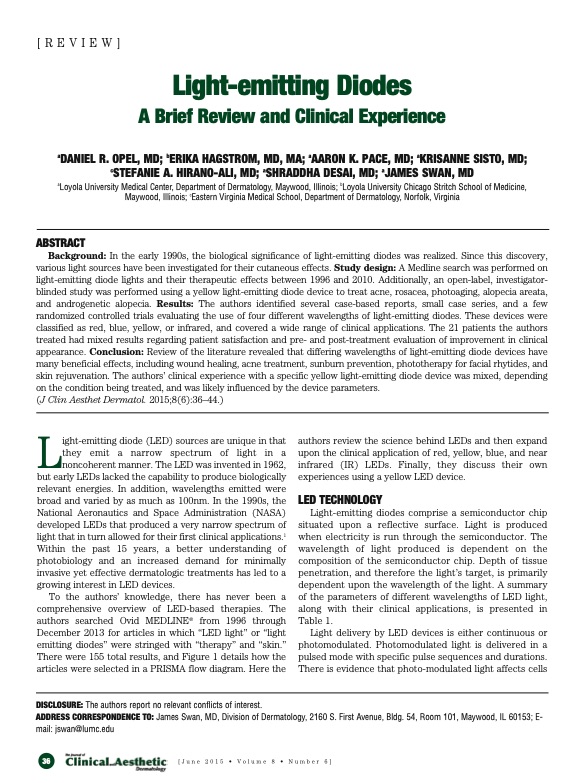
PDF Publication Title:
Text from PDF Page: 001
[REVIEW] Light-emitting Diodes A Brief Review and Clinical Experience aDANIEL R. OPEL, MD; bERIKA HAGSTROM, MD, MA; aAARON K. PACE, MD; aKRISANNE SISTO, MD; cSTEFANIE A. HIRANO-ALI, MD; aSHRADDHA DESAI, MD; aJAMES SWAN, MD aLoyola University Medical Center, Department of Dermatology, Maywood, Illinois; bLoyola University Chicago Stritch School of Medicine, Maywood, Illinois; cEastern Virginia Medical School, Department of Dermatology, Norfolk, Virginia ABSTRACT Background: In the early 1990s, the biological significance of light-emitting diodes was realized. Since this discovery, various light sources have been investigated for their cutaneous effects. Study design: A Medline search was performed on light-emitting diode lights and their therapeutic effects between 1996 and 2010. Additionally, an open-label, investigator- blinded study was performed using a yellow light-emitting diode device to treat acne, rosacea, photoaging, alopecia areata, and androgenetic alopecia. Results: The authors identified several case-based reports, small case series, and a few randomized controlled trials evaluating the use of four different wavelengths of light-emitting diodes. These devices were classified as red, blue, yellow, or infrared, and covered a wide range of clinical applications. The 21 patients the authors treated had mixed results regarding patient satisfaction and pre- and post-treatment evaluation of improvement in clinical appearance. Conclusion: Review of the literature revealed that differing wavelengths of light-emitting diode devices have many beneficial effects, including wound healing, acne treatment, sunburn prevention, phototherapy for facial rhytides, and skin rejuvenation. The authors’ clinical experience with a specific yellow light-emitting diode device was mixed, depending on the condition being treated, and was likely influenced by the device parameters. (J Clin Aesthet Dermatol. 2015;8(6):36–44.) Light-emitting diode (LED) sources are unique in that they emit a narrow spectrum of light in a noncoherent manner. The LED was invented in 1962, but early LEDs lacked the capability to produce biologically relevant energies. In addition, wavelengths emitted were broad and varied by as much as 100nm. In the 1990s, the National Aeronautics and Space Administration (NASA) developed LEDs that produced a very narrow spectrum of light that in turn allowed for their first clinical applications.1 Within the past 15 years, a better understanding of photobiology and an increased demand for minimally invasive yet effective dermatologic treatments has led to a growing interest in LED devices. To the authors’ knowledge, there has never been a comprehensive overview of LED-based therapies. The authors searched Ovid MEDLINE® from 1996 through December 2013 for articles in which “LED light” or “light emitting diodes” were stringed with “therapy” and “skin.” There were 155 total results, and Figure 1 details how the articles were selected in a PRISMA flow diagram. Here the authors review the science behind LEDs and then expand upon the clinical application of red, yellow, blue, and near infrared (IR) LEDs. Finally, they discuss their own experiences using a yellow LED device. LED TECHNOLOGY Light-emitting diodes comprise a semiconductor chip situated upon a reflective surface. Light is produced when electricity is run through the semiconductor. The wavelength of light produced is dependent on the composition of the semiconductor chip. Depth of tissue penetration, and therefore the light’s target, is primarily dependent upon the wavelength of the light. A summary of the parameters of different wavelengths of LED light, along with their clinical applications, is presented in Table 1. Light delivery by LED devices is either continuous or photomodulated. Photomodulated light is delivered in a pulsed mode with specific pulse sequences and durations. There is evidence that photo-modulated light affects cells DISCLOSURE: The authors report no relevant conflicts of interest. ADDRESS CORRESPONDENCE TO: James Swan, MD, Division of Dermatology, 2160 S. First Avenue, Bldg. 54, Room 101, Maywood, IL 60153; E- mail: jswan@lumc.edu 36 [June 2015 • Volume 8 • Number 6] 36PDF Image | Light-emitting Diodes A Brief Review and Clinical Experience

PDF Search Title:
Light-emitting Diodes A Brief Review and Clinical ExperienceOriginal File Name Searched:
jcad_8_6_36.pdfDIY PDF Search: Google It | Yahoo | Bing
Cruise Ship Reviews | Luxury Resort | Jet | Yacht | and Travel Tech More Info
Cruising Review Topics and Articles More Info
Software based on Filemaker for the travel industry More Info
The Burgenstock Resort: Reviews on CruisingReview website... More Info
Resort Reviews: World Class resorts... More Info
The Riffelalp Resort: Reviews on CruisingReview website... More Info
| CONTACT TEL: 608-238-6001 Email: greg@cruisingreview.com | RSS | AMP |